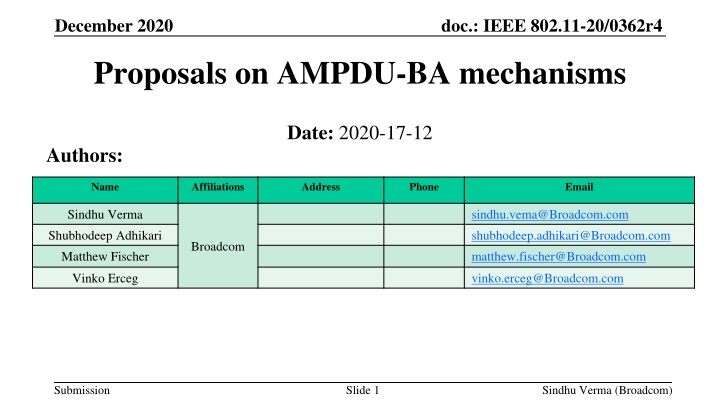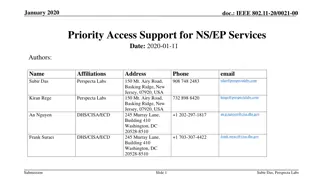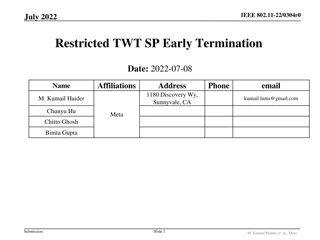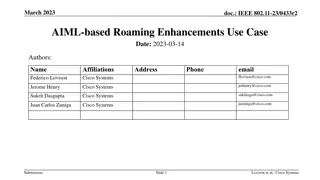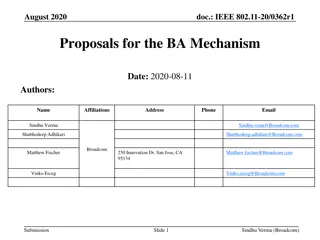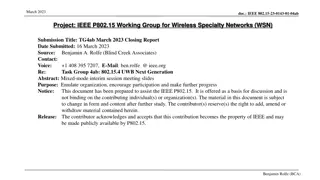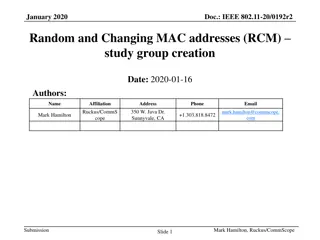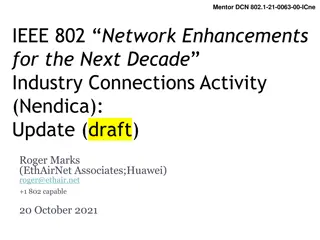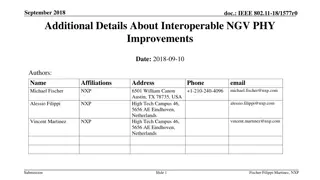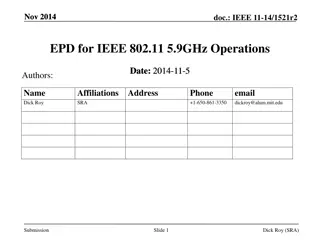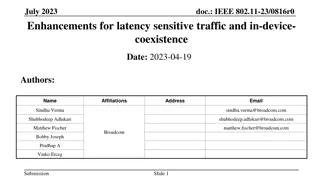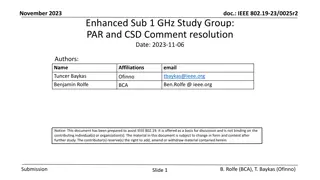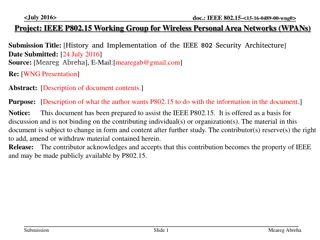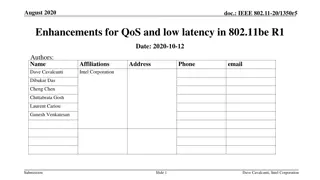Enhancements to IEEE 802.11 AMPDU-BA Mechanisms
This contribution discusses enhancements to the existing AMPDU-BA mechanism for efficiency improvements related to multi-link operation, latency reduction, and in-device coexistence. It addresses limitations, solutions, and flexibility aspects of AMPDU-BA exchanges in IEEE 802.11-20/0362r4.
Download Presentation

Please find below an Image/Link to download the presentation.
The content on the website is provided AS IS for your information and personal use only. It may not be sold, licensed, or shared on other websites without obtaining consent from the author.If you encounter any issues during the download, it is possible that the publisher has removed the file from their server.
You are allowed to download the files provided on this website for personal or commercial use, subject to the condition that they are used lawfully. All files are the property of their respective owners.
The content on the website is provided AS IS for your information and personal use only. It may not be sold, licensed, or shared on other websites without obtaining consent from the author.
E N D
Presentation Transcript
doc.: IEEE 802.11-20/0362r4 December 2020 Proposals on AMPDU-BA mechanisms Date: 2020-17-12 Authors: Name Affiliations Address Phone Email Sindhu Verma Shubhodeep Adhikari Matthew Fischer sindhu.vema@Broadcom.com shubhodeep.adhikari@Broadcom.com matthew.fischer@Broadcom.com Broadcom Vinko Erceg vinko.erceg@Broadcom.com Submission Slide 1 Sindhu Verma (Broadcom)
doc.: IEEE 802.11-20/0362r4 December 2020 Abstract This contribution discusses possible enhancements to the existing AMPDU-BA mechanism to achieve improvements in efficiency especially related to multi- link operation, latency reduction, in-device-coexistence etc. Submission Slide 2 Sindhu Verma (Broadcom)
doc.: IEEE 802.11-20/0362r4 December 2020 Overview (1) AMPDU Recipient limitations Conditional inability to transmit BA after SIFS Rx-Tx switching delay, In-device Coexistence Conditional inability to process later MPDUs of an AMPDU Processing limitations, In-device Coexistence Problems with current solutions HT-immediate BA policy = Block Ack Minimum MPDU Start Spacing field AMPDU Originator limitations Requirement of a time margin for AMPDU construction Reacting to asynchronous events on different links of an MLD Submission Slide 3 Sindhu Verma (Broadcom)
doc.: IEEE 802.11-20/0362r4 December 2020 Overview (2) Other flexibility limitations of AMPDU BA Exchange Handling of latency-sensitive transmissions Handling of degraded reception/CCA Link Adaptation convergence For NSTR ML recipients, requirement to align PPDUs on both links Solutions for AMPDU Recipient limitations AMPDU Originator limitations Other flexibility limitations of AMPDU BA Exchange Straw Polls Reference Submission Slide 4 Sindhu Verma (Broadcom)
doc.: IEEE 802.11-20/0362r4 December 2020 AMPDU Recipient limitations (1) An AMPDU recipient is required to respond with BA at SIFS after the eliciting AMPDU s PPDU A recipient might sometimes be incapable of transmitting the BA at SIFS due to: RX-TX switching delay In device coexistence constraints: The recipient may have an upcoming burst of activity on another in-device technology like Bluetooth/LTE/NR which would prevent it from transmitting BA due to in-device leakage A recipient might sometimes be incapable of receiving later MPDUs within an AMPDU due to: Internal processing limitations (e.g. processing delay beyond SIFS, based on MCS/byte count/MPDU count, etc) In-device coexistence constraints where an upcoming burst of activity on another technology would prevent reception due to in-device leakage Submission Slide 5 Sindhu Verma (Broadcom)
doc.: IEEE 802.11-20/0362r4 December 2020 AMPDU Recipient Limitations (2) Problems with current solutions: HT-immediate Block Ack Policy: Block Ack This does not allow the originator to obtain assistance from the recipient Minimum MPDU Start Spacing (parameter to take care of processing constraints) It specifies the minimum spacing between any 2 MPDUs in microseconds irrespective of the MCS/bandwidth/MIMO order, etc used. The spacing needs to be guaranteed even through padding which wastes transmission resources. It is desirable if the solution gets exercised only if the specified maximum MPDU count/MPDU byte count are exceeded at the recipient and without wastage of resources. Submission Slide 6 Sindhu Verma (Broadcom)
doc.: IEEE 802.11-20/0362r4 December 2020 AMPDU Originator limitations (1) Implementation constraints of MLO may require a time margin for AMPDU construction Example 1: The MLD may be prepared to transmit AMPDUs simultaneously on both the links and may have prepared transmissions accordingly with different sequence number sets. However, if one of the links wins access first or if the other link becomes busy, the earlier sequence numbers would preferably need to be transmitted on the winning link especially in case of an NSTR/ESR MLD. Example 2: If the bandwidth for which access to any link is won, is different from what was assumed while preparing disjoint sets of transmissions for the two links, the AMPDU contents may need to be assembled again. Example 3: An STR MLD which wants to align PPDUs on 2 links, may be waiting to decode length information of a transmission from an NSTR ML device on one of the links (say link1) while it wins access to the other link (say link2). If the STR MLD does not align the end of its link2 transmission with the end of its link1 reception, the NSTR ML device having missed the link2 preamble, may collide with the link2 transmission. Slide 7 Submission Sindhu Verma (Broadcom)
doc.: IEEE 802.11-20/0362r4 December 2020 AMPDU Originator limitations (2) Events on a link 1 might impact decisions regarding transmissions on a link 2. For e.g. the MLD might receive BA correctly on link 1 but not on link 2, and in an asynchronous manner. In this case, the transmitter MLD may want the flexibility to prioritize retransmissions of erroneous packets from link 2 even though link 1 transmission started earlier than the end of link 2 transmission. The LENGTH and contents of an AMPDU cannot be adjusted once the transmission of a PPDU starts, as LENGTH is contained in the L-SIG. Transmitting without rebuilding in some cases may cause unnecessary retransmission of MPDUs or transmission of MPDUs with unnecessary gaps in sequence numbers). Submission Slide 8 Sindhu Verma (Broadcom)
doc.: IEEE 802.11-20/0362r4 December 2020 Other flexibility limitations of AMPDU BA Exchange Handling of latency sensitive transmissions If latency-sensitive traffic arrives newly, it needs to wait for the end of an ongoing transmission burst/TXOP before it can be transmitted. AMPDUs are typically constructed as long as feasible, since longer AMPDUs increase MAC efficiency by omitting intermediate PHY header/SIFS/BA. For long AMPDUs, if the initial PHY header is missed, decoding fails for the receiving device and preamble detection fails for any device performing CCA The problem is especially pronounced in case of hidden nodes, fading channels and blindness in NSTR/ESR ML devices. For the purpose of link adaptation convergence, multiple MCSs/NSSs cannot be tried together and each combination must be tried one at a time followed by a corresponding feedback In case of NSTR ML recipients, PPDUs on the two links may need to be aligned so that UL transmission of BA on one link is not destructive to reception on another link. Submission Slide 9 Sindhu Verma (Broadcom)
doc.: IEEE 802.11-20/0362r4 December 2020 Solutions for AMPDU Recipient limitations (1) AMPDU Recipient indicates its limitations to AMPDU originator Maximum MPDU count, maximum byte count to transmit BA at SIFS Minimum delay, maximum delay for BA transmission In device coexistence issues if they exist. AMPDU Originator allows for delayed BA response If the AMPDU originator follows the recipient s limitations e.g. transmits AMPDUs which fall below the indicated limits, and recipient has not signaled that coexistence issues are present AMPDU Originator interprets lack of BA at SIFS as failure Otherwise, AMPDU originator interprets lack of BA as delayed BA Submission Slide 10 Sindhu Verma (Broadcom)
doc.: IEEE 802.11-20/0362r4 December 2020 Solutions for AMPDU Recipient limitations (2) If the AMPDU Originator interprets lack of BA as delayed BA It assumes that the missing BA will be transmitted by the recipient after a negotiated minimum delay X and before a maximum delay Y, either using contention OR Triggered by a BAR The expiry of maximum delay will lead to the assumption at the originator that the AMPDU is in error It optionally continues with TXOP (i.e. after PIFS) transmitting the next PPDU to same recipient or other recipient(s) AMPDU Recipient exercising delayed BA If the recipient transmits BA within SIFS, the BA indicates the last processed sequence number of the AMPDU (<=last sequence number in the AMPDU) . Else when transmitted, the BA should be cumulative in terms of ACK information e.g. if additional AMPDUs arrive before BA is transmitted Submission Slide 11 Sindhu Verma (Broadcom)
doc.: IEEE 802.11-20/0362r4 December 2020 Solutions for AMPDU Originator limitations A short PPDU (AMPDU) could precede a longer PPDU (AMPDU) with either SIFS gap or no gap in between. Inserting SIFS+BA+SIFS between the two AMPDUs would lead to wastage. It might also cause a problem with synchronous MLD receivers. It helps if there is flexibility to insert a small PPDU in the beginning after which the PPDU with desired final length and contents can occur. This would allow the AMPDU Originator: A time margin to build/rebuild AMPDUs based on the link that wins channel access and the bandwidth with which it wins channel access or while waiting to decode length information for the purpose of alignment An option to react to asynchronous events on the multiple links of the MLD. So, the MLD could tentatively use a small PPDU at the beginning of link 1 transmission and follow it up with a larger PPDU depending on the ACK status on link 2. Submission Slide 12 Sindhu Verma (Broadcom)
doc.: IEEE 802.11-20/0362r4 December 2020 Solutions for AMPDU Originator Flexibility (1) The Originator may not desire BA after SIFS because: It intends to send sequence of AMPDUs (with no gaps or SIFS gap) E.g. for handling latency sensitive traffic, MCS exploration for link adaptation, improving decoding/CCA (details later) There are known recipient limitations vs AMPDU contents E.g. AMPDU exceeds maximum byte count indicated by the recipient In this case: The originator indicates a provision/desire for delayed BA (to a recipient that indicates capability) E.g. indication in PHY header or MAC header OR Ack Policy = Block Ack (within the HT- immediate context) After signaling, the originator is free to transmit again after SIFS or even without any gap The originator will elicit a BA later e.g. using Implicit BAR / explicit BAR Optionally allows the recipient to initiate BA transmission e.g. within the recipient s own TXOP Slide 13 Submission Sindhu Verma (Broadcom)
doc.: IEEE 802.11-20/0362r4 December 2020 Solutions for AMPDU Originator flexibility (2) Handling latency-sensitive traffic Allowing multiple PPDUs with SIFS gap or no gap in between can also help better prioritize latency sensitive traffic and hence reduce latency For example, this can enable the insertion of latency sensitive traffic in an ongoing transmission, rather than wait for the end of the ongoing transmission burst/TXOP When low-latency packets are anticipated, long PPDUs in a TXOP can be broken into a sequence of shorter PPDUs to allow insertion of low latency traffic Submission Slide 14 Sindhu Verma (Broadcom)
doc.: IEEE 802.11-20/0362r4 December 2020 Solutions for AMPDU Originator flexibility (3) Decoding/CCA failure for long AMPDUs/PPDUs The problem can be alleviated if instead of a long PPDU, a sequence of shorter back-to-back PPDUs without gaps or with SIFS gap can be transmitted followed by a single composite BA. Even if any intermediate PPDUs are in error, the remaining can be decoded This will result in better throughput at the receiver in case of fading/dynamic channels. This will also help collision avoidance through preamble detection especially in case of blindness in NSTR/eSR ML devices, since such a device will get to decode multiple preambles instead of only one for the same amount of data transmission and without the overhead of repeated SIFS+BA Submission Slide 15 Sindhu Verma (Broadcom)
doc.: IEEE 802.11-20/0362r4 December 2020 Solutions for AMPDU Originator flexibility (4) Link Adaptation Convergence Convergence of the link adaptation algorithm can be made faster if a composite feedback can be obtained for a back-to-back PPDU (AMPDU) sequence with multiple MCSs/NSSs. The transmitter can pack back-to-back PPDUs each with a different MCS/NSS combination without any gap or with SIFS gap. At the end of the burst, a composite BA is elicited which helps the transmitter know which MCS/NSS combination was the most successful. Not having intermediate BA (and SIFS) helps increase efficiency. Flexibility for NSTR ML recipients To avoid UL transmission from the recipient that may cause destructive interference to recipient s ongoing reception on another link, the Originator can perform consecutive DL transmissions to multiple recipients and then trigger BA in an MU fashion. Submission Slide 16 Sindhu Verma (Broadcom)
doc.: IEEE 802.11-20/0362r4 December 2020 Straw Poll 1 Do you support the inclusion of the following in the SFD: 802.11be AMPDU-BA exchange mechanism allows for the following enhancements: Recipient indication of constraints regarding immediate BA transmission Maximum MPDU count, maximum byte count of AMPDU to meet SIFS response time for BA transmission Minimum delay, maximum delay for BA transmission In-device coexistence issues Originator indication within a PPDU that a BA transmission at SIFS after the PPDU is not permitted. Y/N/A Submission Slide 17 Sindhu Verma (Broadcom)
doc.: IEEE 802.11-20/0362r4 December 2020 Straw Poll 2 Do you support the inclusion of the following in the SFD: 802.11be AMPDU-BA exchange mechanism allows for the following enhancement: Transmission by the AMPDU originator of PPDUs without any intervening gaps or with SIFS gap, where each PPDU is allowed to have different MCS/NSS/duration. Y/N/A Submission Slide 18 Sindhu Verma (Broadcom)
doc.: IEEE 802.11-20/0362r4 December 2020 Reference [1] Draft P802.11REVmd_D3.4 [2] Draft P802.11ax_D6.1 Submission Slide 19 Sindhu Verma (Broadcom)
